Một hệ thống chống ngủ gật cho các lái xe sử dụng Raspberry
A traffic accident is a serious threat to human
life. Association for Safe International Road
Travel(ASIRT) pointed out that: in many causes of
human death today traffic accident ranked in 9th
place (after the epidemic, the war, etc) and if the
situation does not improve, it is in 5th place by 2030
[1]. One of the main causes of traffic accidents
is drowsy drivers. According to the estimation
by the United States International Traffic Safety
Administration, each year, about 328.000 traffic
accidents occur due to driver drowsiness and
fatigue, resulting in about 6.400 deaths, causing $
109 billion in annual damage [2]. Research by the
agency also found that 52% of crashes in heavy
trucks were caused by driver drowsiness, and 37%
of adults surveyed said they were sleepy when
driving at least once.
Drowsiness is a common expression when tired,
such as focusing on driving continuously for long
periods and then the driver’s ability to observe,
react is greatly reduced do not promptly reflect
to avoid dangerous situations when approaching
obstacles or other means of transport. Therefore,
drowsiness seriously affects the ability to drive and
just a few seconds of drowsiness, the accident can
occur and cause serious consequences. In the
face of increasingly complicated traffic accidents,
traffic safety issues for many countries around
the world have become extremely important and
urgent issues.
Recently, methods of detecting drowsiness have
been paid special attention by many researchers
to create smart cars. Specifically, the methods of
detecting drowsiness can be divided into three
main groups:
(1) Based on means;
(2) Based on the physiology of the driver;
(3) Based on the driving behavior;
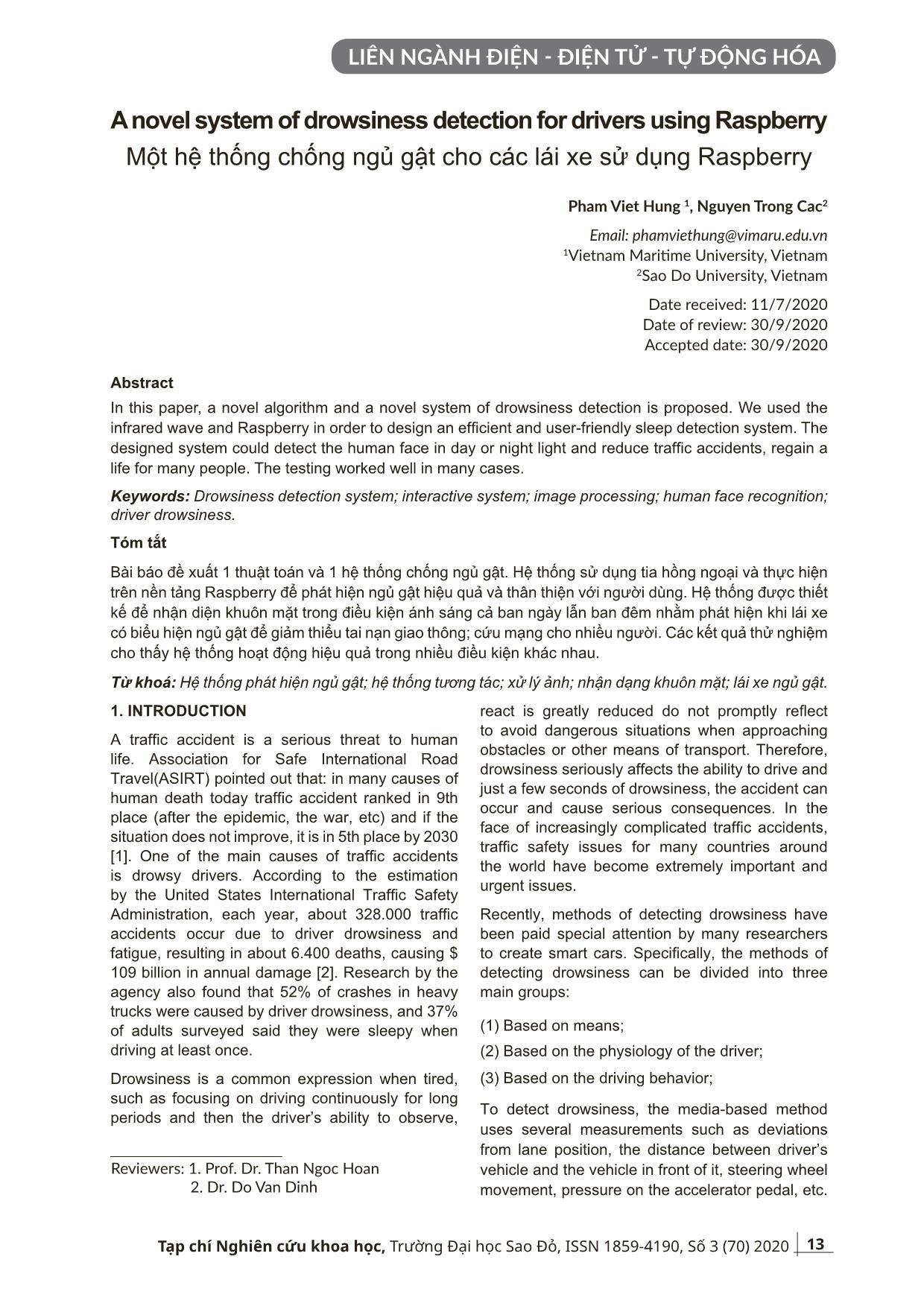
Trang 1
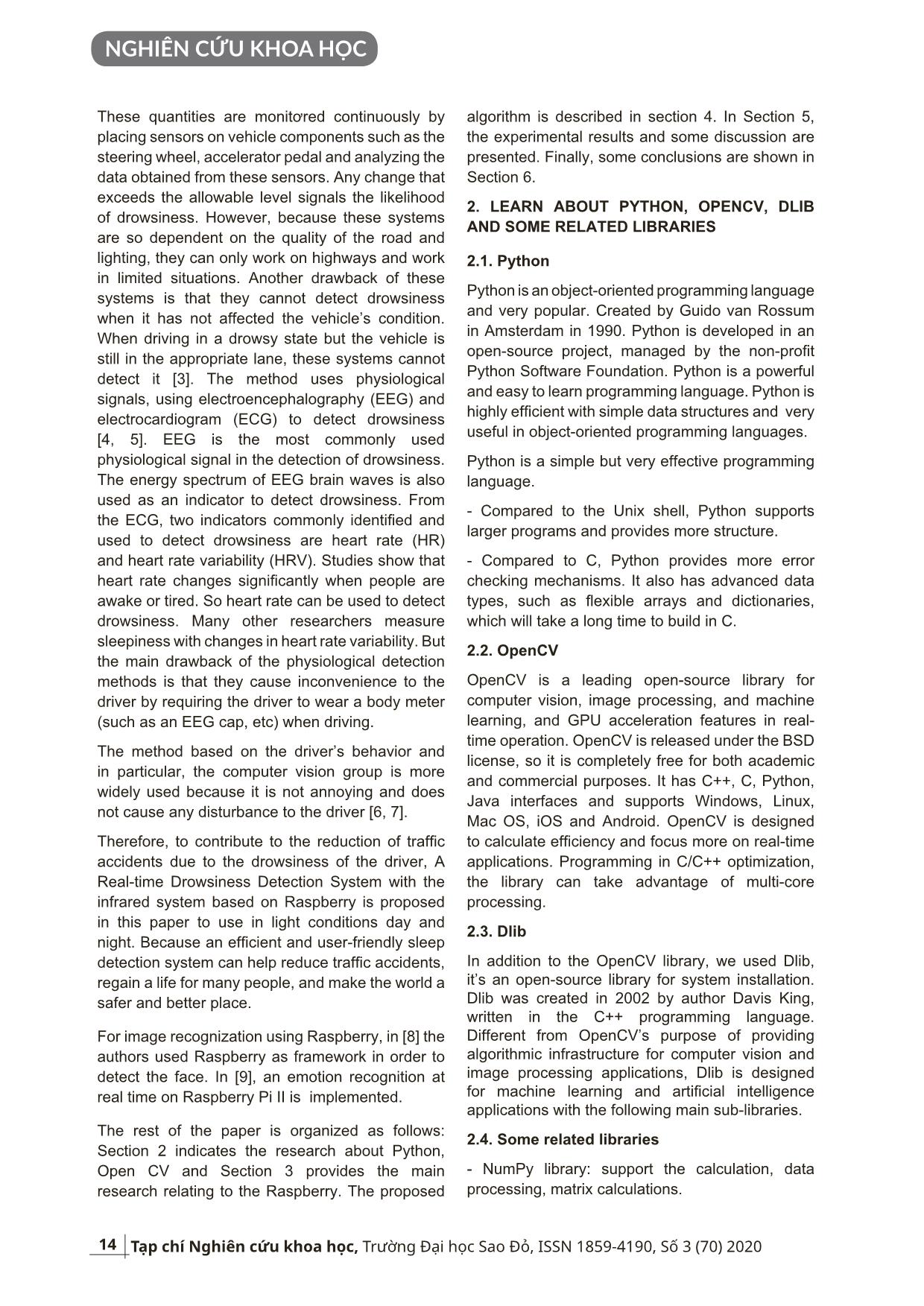
Trang 2
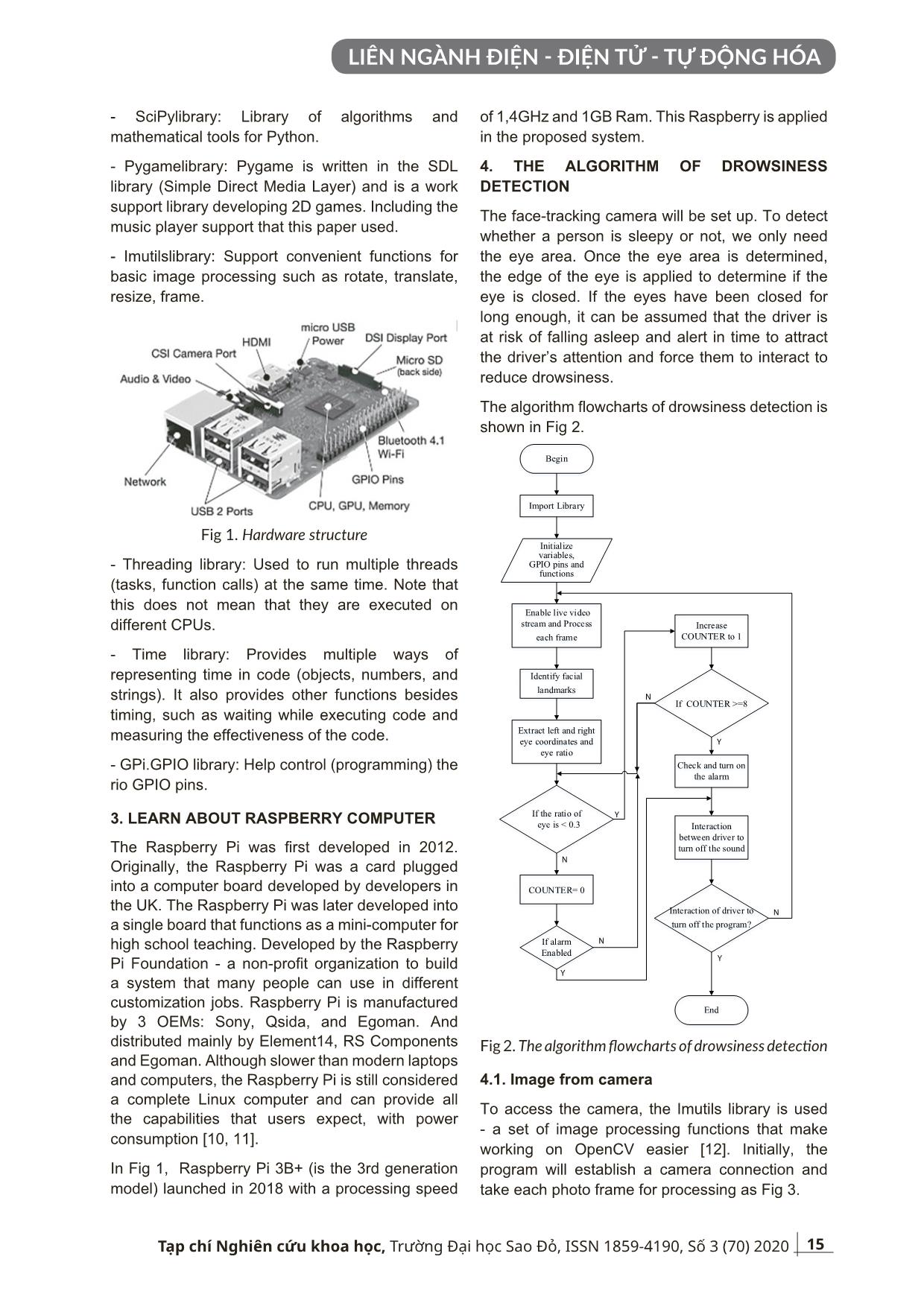
Trang 3
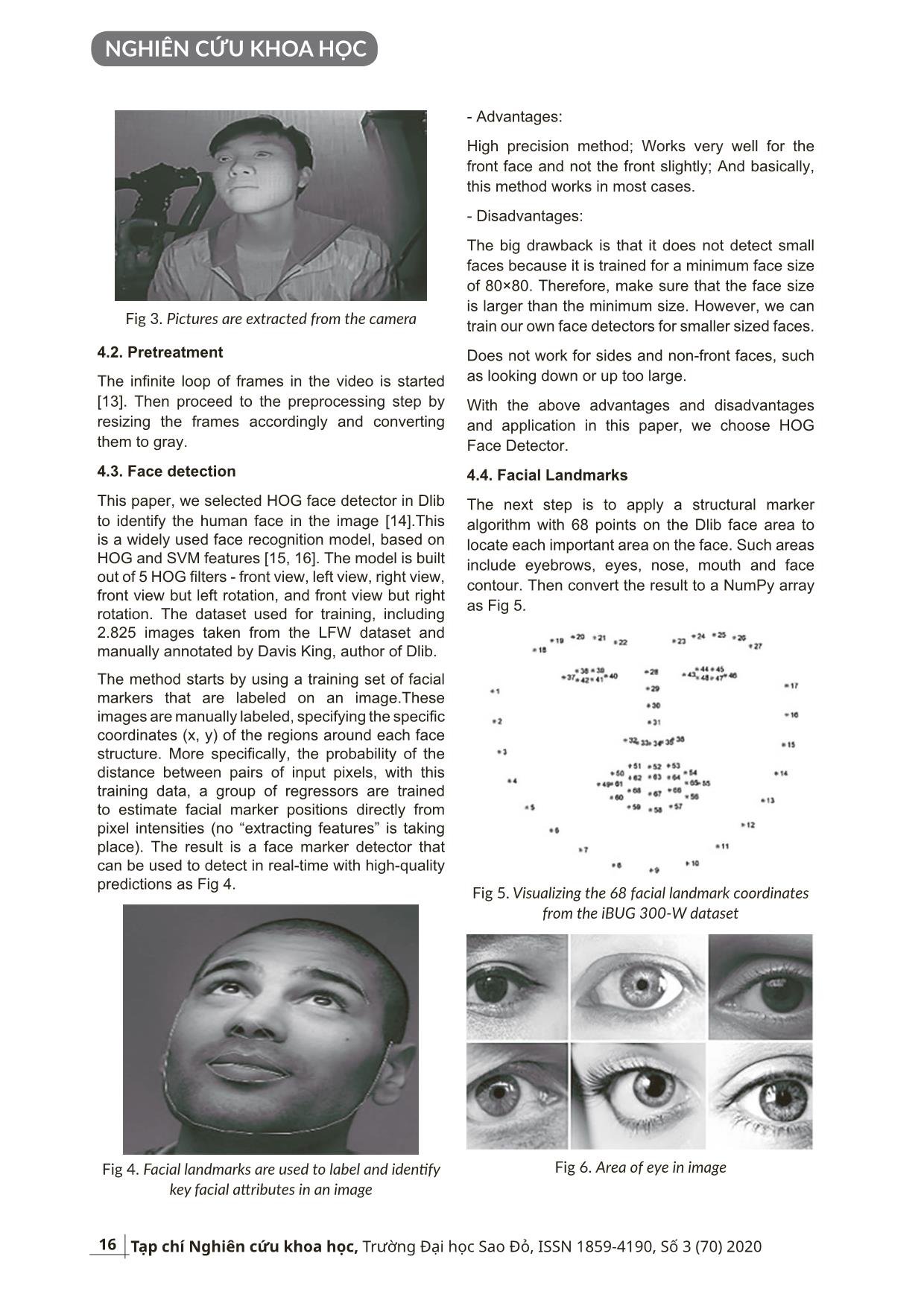
Trang 4
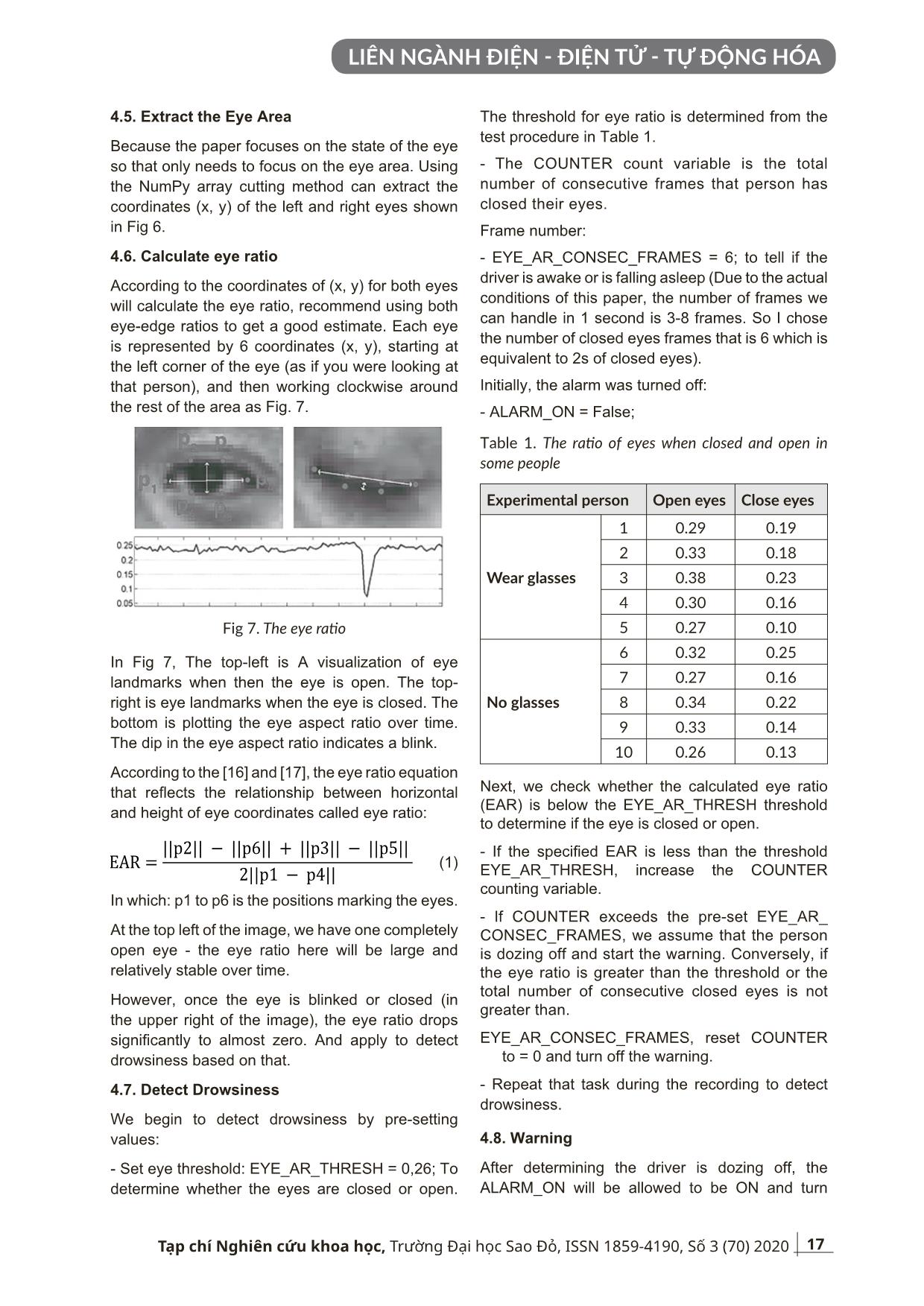
Trang 5
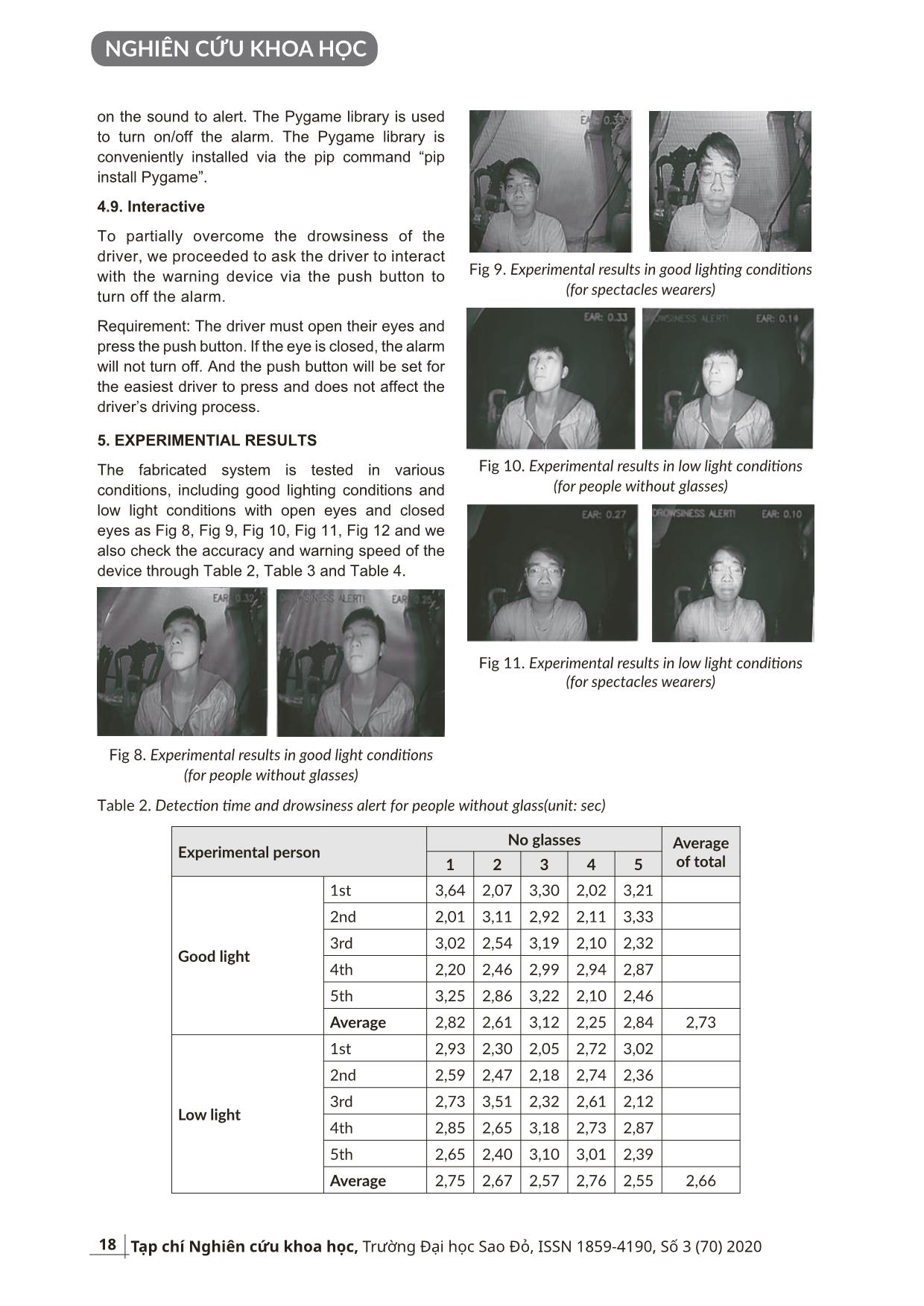
Trang 6
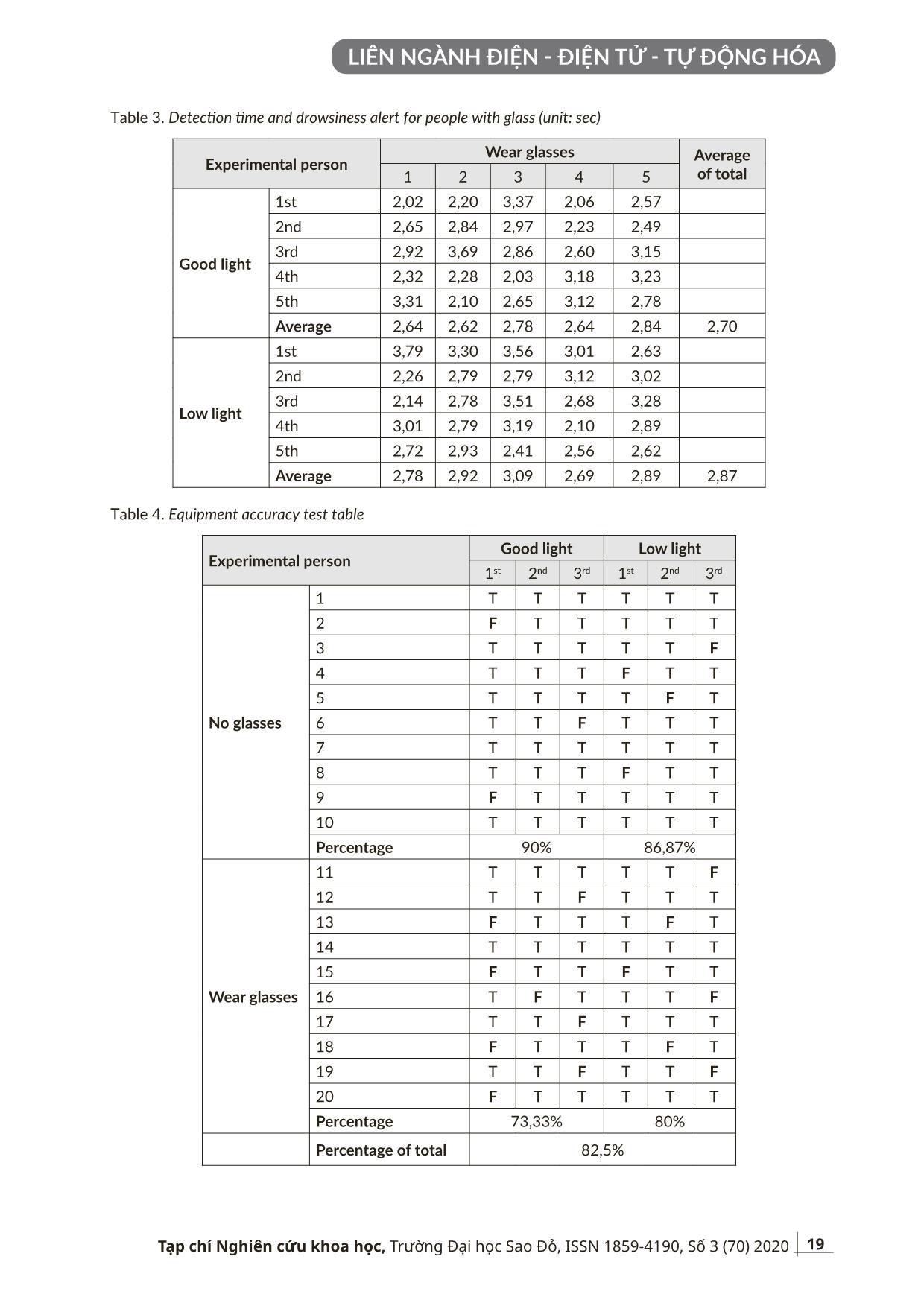
Trang 7
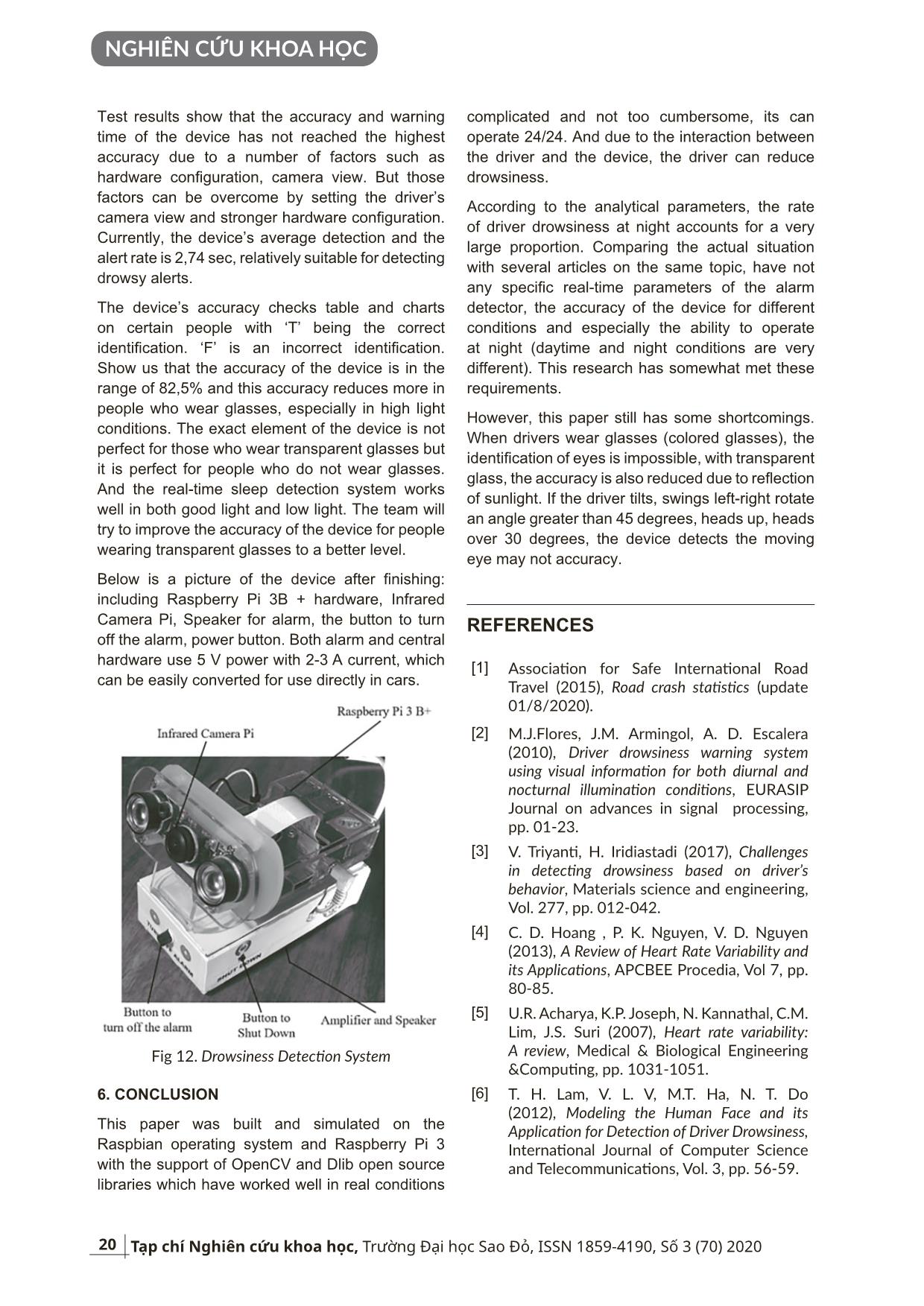
Trang 8
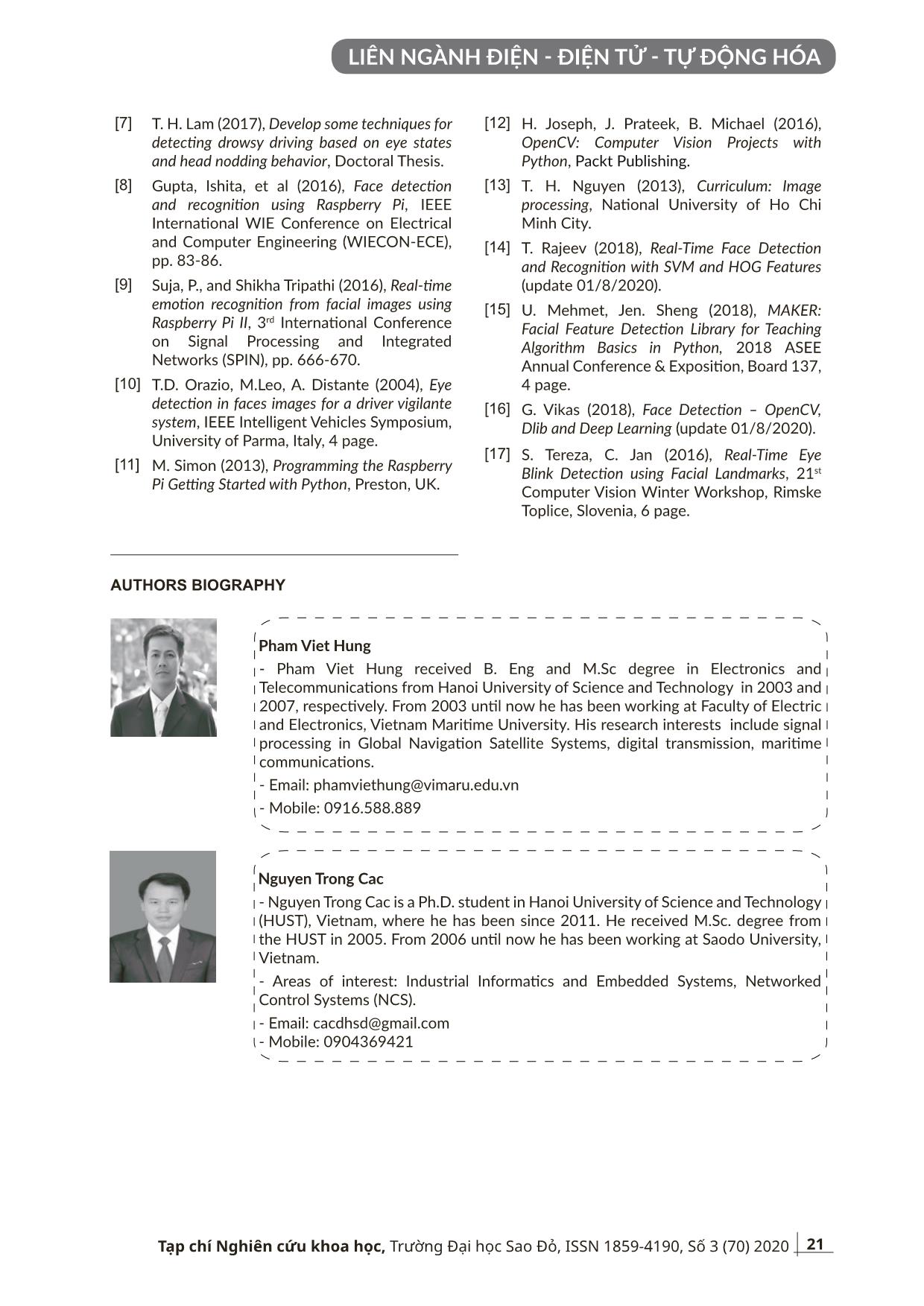
Trang 9
Tóm tắt nội dung tài liệu: Một hệ thống chống ngủ gật cho các lái xe sử dụng Raspberry
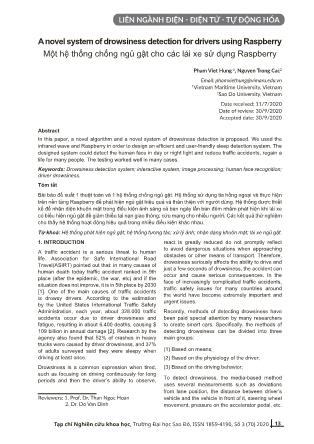
13 LIÊN NGÀNH ĐIỆN - ĐIỆN TỬ - TỰ ĐỘNG HÓA Tạp chí Nghiên cứu khoa học, Trường Đại học Sao Đỏ, ISSN 1859-4190, Số 3 (70) 2020 A novel system of drowsiness detection for drivers using Raspberry Một hệ thống chống ngủ gật cho các lái xe sử dụng Raspberry Pham Viet Hung 1, Nguyen Trong Cac2 Email: phamviethung@vimaru.edu.vn 1Vietnam Maritime University, Vietnam 2Sao Do University, Vietnam Date received: 11/7/2020 Date of review: 30/9/2020 Accepted date: 30/9/2020 Abstract In this paper, a novel algorithm and a novel system of drowsiness detection is proposed. We used the infrared wave and Raspberry in order to design an efficient and user-friendly sleep detection system. The designed system could detect the human face in day or night light and reduce traffic accidents, regain a life for many people. The testing worked well in many cases. Keywords: Drowsiness detection system; interactive system; image processing; human face recognition; driver drowsiness. Tóm tắt Bài báo đề xuất 1 thuật toán và 1 hệ thống chống ngủ gật. Hệ thống sử dụng tia hồng ngoại và thực hiện trên nền tảng Raspberry để phát hiện ngủ gật hiệu quả và thân thiện với người dùng. Hệ thống được thiết kế để nhận diện khuôn mặt trong điều kiện ánh sáng cả ban ngày lẫn ban đêm nhằm phát hiện khi lái xe có biểu hiện ngủ gật để giảm thiểu tai nạn giao thông; cứu mạng cho nhiều người. Các kết quả thử nghiệm cho thấy hệ thống hoạt động hiệu quả trong nhiều điều kiện khác nhau. Từ khoá: Hệ thống phát hiện ngủ gật; hệ thống tương tác; xử lý ảnh; nhận dạng khuôn mặt; lái xe ngủ gật. 1. INTRODUCTION A traffic accident is a serious threat to human life. Association for Safe International Road Travel(ASIRT) pointed out that: in many causes of human death today traffic accident ranked in 9th place (after the epidemic, the war, etc) and if the situation does not improve, it is in 5th place by 2030 [1]. One of the main causes of traffic accidents is drowsy drivers. According to the estimation by the United States International Traffic Safety Administration, each year, about 328.000 traffic accidents occur due to driver drowsiness and fatigue, resulting in about 6.400 deaths, causing $ 109 billion in annual damage [2]. Research by the agency also found that 52% of crashes in heavy trucks were caused by driver drowsiness, and 37% of adults surveyed said they were sleepy when driving at least once. Drowsiness is a common expression when tired, such as focusing on driving continuously for long periods and then the driver’s ability to observe, react is greatly reduced do not promptly reflect to avoid dangerous situations when approaching obstacles or other means of transport. Therefore, drowsiness seriously affects the ability to drive and just a few seconds of drowsiness, the accident can occur and cause serious consequences. In the face of increasingly complicated traffic accidents, traffic safety issues for many countries around the world have become extremely important and urgent issues. Recently, methods of detecting drowsiness have been paid special attention by many researchers to create smart cars. Specifically, the methods of detecting drowsiness can be divided into three main groups: (1) Based on means; (2) Based on the physiology of the driver; (3) Based on the driving behavior; To detect drowsiness, the media-based method uses several measurements such as deviations from lane position, the distance between driver’s vehicle and the vehicle in front of it, steering wheel movement, pressure on the accelerator pedal, etc. Reviewers: 1. Prof. Dr. Than Ngoc Hoan 2. Dr. Do Van Dinh 14 NGHIÊN CỨU KHOA HỌC Tạp chí Nghiên cứu khoa học, Trường Đại học Sao Đỏ, ISSN 1859-4190, Số 3 (70) 2020 These quantities are monitơred continuously by placing sensors on vehicle components such as the steering wheel, accelerator pedal and analyzing the data obtained from these sensors. Any change that exceeds the allowable level signals the likelihood of drowsiness. However, because these systems are so dependent on the quality of the road and lighting, they can only work on highways and work in limited situations. Another drawback of these systems is that they cannot detect drowsiness when it has not affected the vehicle’s condition. When driving in a drowsy state but the vehicle is still in the appropriate lane, these systems cannot detect it [3]. The method uses physiological signals, using electroencephalography (EEG) and electrocardiogram (ECG) to detect drowsiness [4, 5]. EEG is the most commonly used physiological signal in the detection of drowsiness. The energy spectrum of EEG brain waves is also used as an indicator to detect drowsiness. From the ECG, two indicators commonly identified and used to detect drowsiness are heart rate (HR) and heart rate variability (HRV). Studies show that heart rate changes s ... w, left view, right view, front view but left rotation, and front view but right rotation. The dataset used for training, including 2.825 images taken from the LFW dataset and manually annotated by Davis King, author of Dlib. The method starts by using a training set of facial markers that are labeled on an image.These images are manually labeled, specifying the specific coordinates (x, y) of the regions around each face structure. More specifically, the probability of the distance between pairs of input pixels, with this training data, a group of regressors are trained to estimate facial marker positions directly from pixel intensities (no “extracting features” is taking place). The result is a face marker detector that can be used to detect in real-time with high-quality predictions as Fig 4. Fig 4. Facial landmarks are used to label and identify key facial attributes in an image - Advantages: High precision method; Works very well for the front face and not the front slightly; And basically, this method works in most cases. - Disadvantages: The big drawback is that it does not detect small faces because it is trained for a minimum face size of 80×80. Therefore, make sure that the face size is larger than the minimum size. However, we can train our own face detectors for smaller sized faces. Does not work for sides and non-front faces, such as looking down or up too large. With the above advantages and disadvantages and application in this paper, we choose HOG Face Detector. 4.4. Facial Landmarks The next step is to apply a structural marker algorithm with 68 points on the Dlib face area to locate each important area on the face. Such areas include eyebrows, eyes, nose, mouth and face contour. Then convert the result to a NumPy array as Fig 5. Fig 5. Visualizing the 68 facial landmark coordinates from the iBUG 300-W dataset Fig 6. Area of eye in image 17 LIÊN NGÀNH ĐIỆN - ĐIỆN TỬ - TỰ ĐỘNG HÓA Tạp chí Nghiên cứu khoa học, Trường Đại học Sao Đỏ, ISSN 1859-4190, Số 3 (70) 2020 4.5. Extract the Eye Area Because the paper focuses on the state of the eye so that only needs to focus on the eye area. Using the NumPy array cutting method can extract the coordinates (x, y) of the left and right eyes shown in Fig 6. 4.6. Calculate eye ratio According to the coordinates of (x, y) for both eyes will calculate the eye ratio, recommend using both eye-edge ratios to get a good estimate. Each eye is represented by 6 coordinates (x, y), starting at the left corner of the eye (as if you were looking at that person), and then working clockwise around the rest of the area as Fig. 7. Fig 7. The eye ratio In Fig 7, The top-left is A visualization of eye landmarks when then the eye is open. The top- right is eye landmarks when the eye is closed. The bottom is plotting the eye aspect ratio over time. The dip in the eye aspect ratio indicates a blink. According to the [16] and [17], the eye ratio equation that reflects the relationship between horizontal and height of eye coordinates called eye ratio:EAR = ||p2|| − ||p6|| + ||p3|| − ||p5|| 2||p1 − p4|| (1) In which: p1 to p6 is the positions marking the eyes. At the top left of the image, we have one completely open eye - the eye ratio here will be large and relatively stable over time. However, once the eye is blinked or closed (in the upper right of the image), the eye ratio drops significantly to almost zero. And apply to detect drowsiness based on that. 4.7. Detect Drowsiness We begin to detect drowsiness by pre-setting values: - Set eye threshold: EYE_AR_THRESH = 0,26; To determine whether the eyes are closed or open. The threshold for eye ratio is determined from the test procedure in Table 1. - The COUNTER count variable is the total number of consecutive frames that person has closed their eyes. Frame number: - EYE_AR_CONSEC_FRAMES = 6; to tell if the driver is awake or is falling asleep (Due to the actual conditions of this paper, the number of frames we can handle in 1 second is 3-8 frames. So I chose the number of closed eyes frames that is 6 which is equivalent to 2s of closed eyes). Initially, the alarm was turned off: - ALARM_ON = False; Table 1. The ratio of eyes when closed and open in some people Experimental person Open eyes Close eyes Wear glasses 1 0.29 0.19 2 0.33 0.18 3 0.38 0.23 4 0.30 0.16 5 0.27 0.10 No glasses 6 0.32 0.25 7 0.27 0.16 8 0.34 0.22 9 0.33 0.14 10 0.26 0.13 Next, we check whether the calculated eye ratio (EAR) is below the EYE_AR_THRESH threshold to determine if the eye is closed or open. - If the specified EAR is less than the threshold EYE_AR_THRESH, increase the COUNTER counting variable. - If COUNTER exceeds the pre-set EYE_AR_ CONSEC_FRAMES, we assume that the person is dozing off and start the warning. Conversely, if the eye ratio is greater than the threshold or the total number of consecutive closed eyes is not greater than. EYE_AR_CONSEC_FRAMES, reset COUNTER to = 0 and turn off the warning. - Repeat that task during the recording to detect drowsiness. 4.8. Warning After determining the driver is dozing off, the ALARM_ON will be allowed to be ON and turn 18 NGHIÊN CỨU KHOA HỌC Tạp chí Nghiên cứu khoa học, Trường Đại học Sao Đỏ, ISSN 1859-4190, Số 3 (70) 2020 on the sound to alert. The Pygame library is used to turn on/off the alarm. The Pygame library is conveniently installed via the pip command “pip install Pygame”. 4.9. Interactive To partially overcome the drowsiness of the driver, we proceeded to ask the driver to interact with the warning device via the push button to turn off the alarm. Requirement: The driver must open their eyes and press the push button. If the eye is closed, the alarm will not turn off. And the push button will be set for the easiest driver to press and does not affect the driver’s driving process. 5. EXPERIMENTIAL RESULTS The fabricated system is tested in various conditions, including good lighting conditions and low light conditions with open eyes and closed eyes as Fig 8, Fig 9, Fig 10, Fig 11, Fig 12 and we also check the accuracy and warning speed of the device through Table 2, Table 3 and Table 4. Fig 8. Experimental results in good light conditions (for people without glasses) Fig 9. Experimental results in good lighting conditions (for spectacles wearers) Fig 10. Experimental results in low light conditions (for people without glasses) Fig 11. Experimental results in low light conditions (for spectacles wearers) Table 2. Detection time and drowsiness alert for people without glass(unit: sec) Experimental person No glasses Average of total1 2 3 4 5 Good light 1st 3,64 2,07 3,30 2,02 3,21 2nd 2,01 3,11 2,92 2,11 3,33 3rd 3,02 2,54 3,19 2,10 2,32 4th 2,20 2,46 2,99 2,94 2,87 5th 3,25 2,86 3,22 2,10 2,46 Average 2,82 2,61 3,12 2,25 2,84 2,73 Low light 1st 2,93 2,30 2,05 2,72 3,02 2nd 2,59 2,47 2,18 2,74 2,36 3rd 2,73 3,51 2,32 2,61 2,12 4th 2,85 2,65 3,18 2,73 2,87 5th 2,65 2,40 3,10 3,01 2,39 Average 2,75 2,67 2,57 2,76 2,55 2,66 19 LIÊN NGÀNH ĐIỆN - ĐIỆN TỬ - TỰ ĐỘNG HÓA Tạp chí Nghiên cứu khoa học, Trường Đại học Sao Đỏ, ISSN 1859-4190, Số 3 (70) 2020 Table 3. Detection time and drowsiness alert for people with glass (unit: sec) Experimental person Wear glasses Average of total1 2 3 4 5 Good light 1st 2,02 2,20 3,37 2,06 2,57 2nd 2,65 2,84 2,97 2,23 2,49 3rd 2,92 3,69 2,86 2,60 3,15 4th 2,32 2,28 2,03 3,18 3,23 5th 3,31 2,10 2,65 3,12 2,78 Average 2,64 2,62 2,78 2,64 2,84 2,70 Low light 1st 3,79 3,30 3,56 3,01 2,63 2nd 2,26 2,79 2,79 3,12 3,02 3rd 2,14 2,78 3,51 2,68 3,28 4th 3,01 2,79 3,19 2,10 2,89 5th 2,72 2,93 2,41 2,56 2,62 Average 2,78 2,92 3,09 2,69 2,89 2,87 Table 4. Equipment accuracy test table Experimental person Good light Low light1st 2nd 3rd 1st 2nd 3rd No glasses 1 T T T T T T 2 F T T T T T 3 T T T T T F 4 T T T F T T 5 T T T T F T 6 T T F T T T 7 T T T T T T 8 T T T F T T 9 F T T T T T 10 T T T T T T Percentage 90% 86,87% Wear glasses 11 T T T T T F 12 T T F T T T 13 F T T T F T 14 T T T T T T 15 F T T F T T 16 T F T T T F 17 T T F T T T 18 F T T T F T 19 T T F T T F 20 F T T T T T Percentage 73,33% 80% Percentage of total 82,5% 20 NGHIÊN CỨU KHOA HỌC Tạp chí Nghiên cứu khoa học, Trường Đại học Sao Đỏ, ISSN 1859-4190, Số 3 (70) 2020 Test results show that the accuracy and warning time of the device has not reached the highest accuracy due to a number of factors such as hardware configuration, camera view. But those factors can be overcome by setting the driver’s camera view and stronger hardware configuration. Currently, the device’s average detection and the alert rate is 2,74 sec, relatively suitable for detecting drowsy alerts. The device’s accuracy checks table and charts on certain people with ‘T’ being the correct identification. ‘F’ is an incorrect identification. Show us that the accuracy of the device is in the range of 82,5% and this accuracy reduces more in people who wear glasses, especially in high light conditions. The exact element of the device is not perfect for those who wear transparent glasses but it is perfect for people who do not wear glasses. And the real-time sleep detection system works well in both good light and low light. The team will try to improve the accuracy of the device for people wearing transparent glasses to a better level. Below is a picture of the device after finishing: including Raspberry Pi 3B + hardware, Infrared Camera Pi, Speaker for alarm, the button to turn off the alarm, power button. Both alarm and central hardware use 5 V power with 2-3 A current, which can be easily converted for use directly in cars. Fig 12. Drowsiness Detection System 6. CONCLUSION This paper was built and simulated on the Raspbian operating system and Raspberry Pi 3 with the support of OpenCV and Dlib open source libraries which have worked well in real conditions complicated and not too cumbersome, its can operate 24/24. And due to the interaction between the driver and the device, the driver can reduce drowsiness. According to the analytical parameters, the rate of driver drowsiness at night accounts for a very large proportion. Comparing the actual situation with several articles on the same topic, have not any specific real-time parameters of the alarm detector, the accuracy of the device for different conditions and especially the ability to operate at night (daytime and night conditions are very different). This research has somewhat met these requirements. However, this paper still has some shortcomings. When drivers wear glasses (colored glasses), the identification of eyes is impossible, with transparent glass, the accuracy is also reduced due to reflection of sunlight. If the driver tilts, swings left-right rotate an angle greater than 45 degrees, heads up, heads over 30 degrees, the device detects the moving eye may not accuracy. REFERENCES [1] Association for Safe International Road Travel (2015), Road crash statistics (update 01/8/2020). [2] M.J.Flores, J.M. Armingol, A. D. Escalera (2010), Driver drowsiness warning system using visual information for both diurnal and nocturnal illumination conditions, EURASIP Journal on advances in signal processing, pp. 01-23. [3] V. Triyanti, H. Iridiastadi (2017), Challenges in detecting drowsiness based on driver’s behavior, Materials science and engineering, Vol. 277, pp. 012-042. [4] C. D. Hoang , P. K. Nguyen, V. D. Nguyen (2013), A Review of Heart Rate Variability and its Applications, APCBEE Procedia, Vol 7, pp. 80-85. [5] U.R. Acharya, K.P. Joseph, N. Kannathal, C.M. Lim, J.S. Suri (2007), Heart rate variability: A review, Medical & Biological Engineering &Computing, pp. 1031-1051. [6] T. H. Lam, V. L. V, M.T. Ha, N. T. Do (2012), Modeling the Human Face and its Application for Detection of Driver Drowsiness, International Journal of Computer Science and Telecommunications, Vol. 3, pp. 56-59. 21 LIÊN NGÀNH ĐIỆN - ĐIỆN TỬ - TỰ ĐỘNG HÓA Tạp chí Nghiên cứu khoa học, Trường Đại học Sao Đỏ, ISSN 1859-4190, Số 3 (70) 2020 [7] T. H. Lam (2017), Develop some techniques for detecting drowsy driving based on eye states and head nodding behavior, Doctoral Thesis. [8] Gupta, Ishita, et al (2016), Face detection and recognition using Raspberry Pi, IEEE International WIE Conference on Electrical and Computer Engineering (WIECON-ECE), pp. 83-86. [9] Suja, P., and Shikha Tripathi (2016), Real-time emotion recognition from facial images using Raspberry Pi II, 3rd International Conference on Signal Processing and Integrated Networks (SPIN), pp. 666-670. [10] T.D. Orazio, M.Leo, A. Distante (2004), Eye detection in faces images for a driver vigilante system, IEEE Intelligent Vehicles Symposium, University of Parma, Italy, 4 page. [11] M. Simon (2013), Programming the Raspberry Pi Getting Started with Python, Preston, UK. [12] H. Joseph, J. Prateek, B. Michael (2016), OpenCV: Computer Vision Projects with Python, Packt Publishing. [13] T. H. Nguyen (2013), Curriculum: Image processing, National University of Ho Chi Minh City. [14] T. Rajeev (2018), Real-Time Face Detection and Recognition with SVM and HOG Features (update 01/8/2020). [15] U. Mehmet, Jen. Sheng (2018), MAKER: Facial Feature Detection Library for Teaching Algorithm Basics in Python, 2018 ASEE Annual Conference & Exposition, Board 137, 4 page. [16] G. Vikas (2018), Face Detection – OpenCV, Dlib and Deep Learning (update 01/8/2020). [17] S. Tereza, C. Jan (2016), Real-Time Eye Blink Detection using Facial Landmarks, 21st Computer Vision Winter Workshop, Rimske Toplice, Slovenia, 6 page. AUTHORS BIOGRAPHY Nguyen Trong Cac - Nguyen Trong Cac is a Ph.D. student in Hanoi University of Science and Technology (HUST), Vietnam, where he has been since 2011. He received M.Sc. degree from the HUST in 2005. From 2006 until now he has been working at Saodo University, Vietnam. - Areas of interest: Industrial Informatics and Embedded Systems, Networked Control Systems (NCS). - Email: cacdhsd@gmail.com - Mobile: 0904369421 Pham Viet Hung - Pham Viet Hung received B. Eng and M.Sc degree in Electronics and Telecommunications from Hanoi University of Science and Technology in 2003 and 2007, respectively. From 2003 until now he has been working at Faculty of Electric and Electronics, Vietnam Maritime University. His research interests include signal processing in Global Navigation Satellite Systems, digital transmission, maritime communications. - Email: phamviethung@vimaru.edu.vn - Mobile: 0916.588.889
File đính kèm:
 mot_he_thong_chong_ngu_gat_cho_cac_lai_xe_su_dung_raspberry.pdf
mot_he_thong_chong_ngu_gat_cho_cac_lai_xe_su_dung_raspberry.pdf

